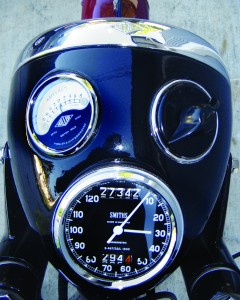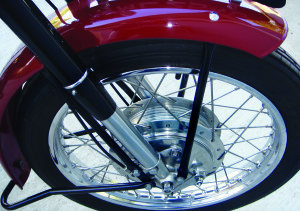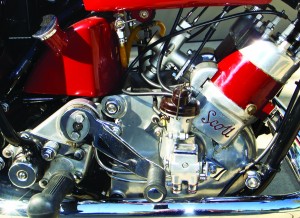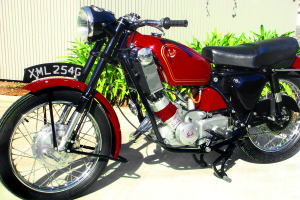(This Retrospective article was published in the September 2008 issue of Rider.)
Story by Clement Salvadori • Photography by Don Danmeier
Anyone shopping for a motorcycle in 1969 had quite a choice, be it a Honda SOHC 750 four, a Triumph Trident OHV 750 triple, or a Laverda/American Eagle SOHC 750 twin.
Those with a two-stroke bent could buy a Kawasaki 500 triple, a Suzuki Titan 500 twin or—if you were extremely well connected in the English city of Birmingham, locally known as Brum—a Scott Flying Squirrel 600 twin. A Flying Squirrel? What squirrel-brain came up with a name like that?
Fair question: the Squirrel name did have a long and noble history, dating back to 1921, and a Scott ad of the era promoting its reliability ran: “As lively as a Squirrel and never sheds a nut.” And while this ’69 version in the photos may look suitably ’60s, with a telescopic fork and swingarm rear suspension, the powerplant was a direct descendant of the ’21 model—which was descended from the first production Scott of 1909.
Where did this cheerful anachronism come from? The water-cooled two-stroke twin, with a two-speed transmission, originated in the fertile mind of one Alfred Angas Scott in the first decade of the last century. No water pump was needed with this engine, as Scott had devised a simple thermo-siphon effect to get the water to and from the radiator. In those early years the Scott had immense success on the British race circuits, so much success that the governing body of racing determined that a two-stroke had a 1.32 advantage over the more popular four-stroke machines, which meant that a 660cc four-stroke could compete against a 500cc two-stroke. Scott left the company after World War I, with several dozen patents to his credit, and died in 1923. An engineer named Harry Shackleton got to work on improving the design, with the first Squirrel appearing in 1921, a 500cc sports model, which became the 600cc Flying Squirrel, with three gears, in 1923.

The Depression arrived a few years later, and while cheap two-stroke commuter bikes were still saleable, the Scott was an expensive motorcycle, and sales were not good. The company went into receivership in 1931, recovered, and a Flying Squirrel with plunger rear suspension was shown in 1939.
In 1946 the Flying Squirrel appeared again, with a rigid frame and girder fork, the latter soon upgraded to a Dowty pneumatic fork, but again the company had financial troubles. In 1950 it was rescued by a Scott enthusiast and toolmaker named Matt Holder, who moved the factory from Shipley, in northern England, to Birmingham.
In 1954 the “Brum” Scotts began to appear, with a modern chassis and slightly improved engine. Although the signature sloping gas tank was an aesthetic challenge to many.

The chassis used a double-cradle frame. The front fork was conventionally telescopic, and the rear swinging fork had a pair of shocks, Girling or Armstrong, depending what was in stock, with three-way spring preload adjustment. The front brake was exceptionally strong, being full-width 7-inch drum with four shoes, having a single-leading-shoe operation on each side; the manufacturer understood that a two-stroke offered little compression braking. The rear single leading shoe was cable operated. The wheels were both 19-inch, with a 3.25 tire on the front, 3.50 on the rear. Wheelbase was a longish 59 inches, and weight with four gallons of gas in the tank was nearly 450 pounds, a little heavier than a contemporary Norton 600 twin.
All quite conventional. Except for the engine, a stunning piece of work, both good looking and functional in a low-revs way. It was a slightly oversquare (73mm bore, 71.4mm stroke) 596cc parallel twin, water-cooled, the cylinders inclined forward about 45 degrees. Down in the die-cast aluminum crankcase the flywheel was in the middle, and separate chambers were on each side. The primary drive did not run off one end of the crankshaft, but from the middle, using a sprocket next to the flywheel. The crank spun on roller bearings set inboard from the ends, and maximum sensible revolutions created a herd of about 30 horses in the neighborhood of 5,000 rpm.

Carburetion was through a single 1-inch Amal, with a remote float bowl, in what was considered to be a very simple three-port, two-stroke design.
Lubrication was effected via a Pilgrim pump, which probably not 1 percent of the readers could define. This was the old-fashioned way of oiling, and was used in the total-loss four-strokes of yore, allowing the rider to determine the amount of oil going into the engine by a sight glass and an adjustable knob, the remnants being burned with the fuel. A smoky exhaust was the sign of a worried rider dialing in too much oil.

Sparking the plugs were coils and a Lucas distributor with an automatic advance. At the left end of the crankshaft was a Lucas six-volt alternator/dynamo. The Smiths speedo in the headlight shell went to an optimistic 120 mph.
That single-row primary had to cope with all the horsepower, and to keep it lubricated there was a manually adjustable valve down by the countershaft sprocket; this was definitely a machine for the rider who knew what he or she was doing. A multidisc dry clutch fed the power to the three-speed gearbox.
Holder realized that this was an enthusiast’s motorcycle, not something to be mass-produced, and volume was low. By 1969 the output was one machine every six months, and soon production ceased entirely. The call for these “expensive anachronisms,” as one magazine described them, could not justify the costs of building one or two a year. However, 40 years later the Scott Owners’ Club has an enthusiastic membership, and the address can be found on your computer.








